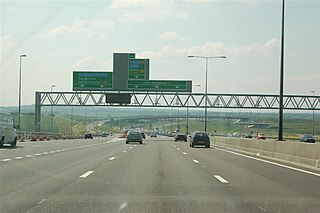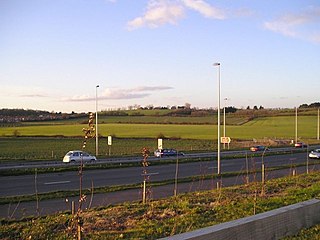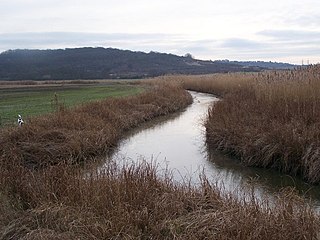Related Research Articles

The Boston Post Road was a system of mail-delivery routes between New York City and Boston, Massachusetts, that evolved into one of the first major highways in the United States.

Medway is a unitary authority district and conurbation in Kent, South East England. It had a population of 278,016 in 2019. The unitary authority was formed in 1998 when Rochester-upon-Medway amalgamated with the Borough of Gillingham to form Medway Towns. It is now a unitary authority area run by Medway Council, independent of Kent County Council but still part of the ceremonial county of Kent.

The A2 is a major road in south-east England, connecting London with the English Channel port of Dover in Kent. This route has always been of importance as a connection between London and sea trade routes to Continental Europe. It was originally known as the Dover Road. The M2 motorway has replaced part of the A2 as the strategic route.

The North Kent Marshes are in the far north of the county of Kent spanning dry and wet south banks and inlets of the Thames Estuary in south-east England. The marshes are one of 22 Environmentally Sensitive Areas recognised by the UK's Department for Environment, Food and Rural Affairs (DEFRA). They are in the Thames Gateway regional planning area. They include the 5,289-hectare (20.4 sq mi) South Thames Estuary and Marshes biological SSSI.

The Hoo Peninsula is a peninsula in Kent, England, separating the estuaries of the rivers Thames and Medway. It is dominated by a line of chalk, clay and sand hills, surrounded by an extensive area of marshland composed of alluvial silt. The name Hoo is a Saxon word believed to mean 'spur of land' or refers to the 'distinct heel-shape of the ridge of hills' through Hoo. Hoo features in the Domesday Book. The peninsula is home to internationally and nationally protected wildlife sites as well as industrial facilities and energy industries.

High Halstow is a village and civil parish on the Hoo Peninsula in the unitary authority of Medway in South East England. It was, until 1998, administratively part of Kent and is still ceremonially associated via the Lieutenancies Act. The parish had a population of 1,781 according to the 2001 census, increasing to 1,807 at the 2011 census.

Hoo St Werburgh, commonly known as Hoo, is a large village and civil parish in the Medway district of Kent, England. It is one of several villages on the Hoo Peninsula to bear the name Hoo, a Saxon word believed to mean "spur of land" or to refer to the "distinct heel-shape of the ridge of hills" through the settlement. Hoo features in Domesday Book, and had a population of 7,356 at the 2001 census, rising to 8,945 at the 2011 census. The civil parish includes Chattenden to the west.

Medway was a county constituency represented in the House of Commons of the Parliament of the United Kingdom between 1983 and 2010. A previous constituency of the same name existed from 1885 to 1918.
Strood Rural District was a rural district in the county of Kent, England.

Cliffe Woods is a small estate on the Hoo Peninsula in the unitary authority of Medway in South East England. It was, until 1998, part of Kent and is still ceremonially associated via the Lieutenancies Act. It forms part of the parish of Cliffe and Cliffe Woods.

Wainscott is a small village in Rochester, in Kent, England. It is in the civil parish of Frindsbury Extra, in the Medway Unitary Authority, that is Medway Council. By 1950 it had been absorbed into the neighbouring residential areas of Strood. Wainscott itself is located immediately next to Frindsbury, and is surrounded by agricultural land and ancient woodlands. It is speculated that the name is derived from the OE meaning Wagonner Cot or Wagon Shed.

The Saxon Shore Way is a long-distance footpath in England. It starts at Gravesend, Kent, and traces the coast of South-East England as it was in Roman times as far as Hastings, East Sussex, 163 miles (262 km) in total. This means that around Romney Marsh the route runs significantly inland from the modern coastline.

The A228 road is an important transport artery in Kent, England. It begins at the Isle of Grain and runs in a south-westerly direction to connect eventually with the A21 trunk road at Pembury. It serves existing communities and new and proposed housing developments and commercial enterprises. The most influential force on the recent upgrading of the road has been the development of Kings Hill near West Malling.

Chattenden is a village within the civil parish of Hoo, which is within the unitary authority of Medway, Kent, England. It was, until 1998, part of Kent and is still ceremonially associated via the Lieutenancies Act. The A228 goes through the village.

National Cycle Route 1 is a route of the National Cycle Network, running from Dover to Tain. The 1,264 mi-long (2,034-kilometre) cycle-path is located in the United Kingdom.

The Hundred of Hoo Railway is a railway line in Kent, England, following the North Kent Line from Gravesend before diverging at Hoo Junction near Shorne Marshes and continuing in an easterly direction across the Hoo Peninsula, passing near the villages of Cooling, High Halstow, Cliffe and Stoke before reaching the Isle of Grain and the container port on its eastern tip, Thamesport. There used to be a short branch line leading from Stoke Junction to the coastal town of Allhallows but this closed from 4 December 1961, the same date on which the Hundred of Hoo line was closed to passenger services.

High Halstow National Nature Reserve is on the Hoo Peninsula north of Chatham. It is also part of the Northwood Hill Royal Society for the Protection of Birds Reserve. It was declared a National Nature Reserve in 1951.

Cliffe is a village on the Hoo Peninsula in Kent, England, reached from the Medway Towns by a three-mile (4.8 km) journey along the B2000 road. Situated upon a low chalk escarpment overlooking the Thames marshes, Cliffe offers views of Southend-on-Sea and London. It forms part of the parish of Cliffe and Cliffe Woods in the borough of Medway. The population of the village is included in the civil parish of Cliffe and Cliffe Woods. In 774 Offa, King of Mercia, built a rustic wooden church dedicated to St Helen, a popular Mercian saint who was by legend the daughter of Coel of Colchester. Cliffe is cited in early records as having been called Clive and Cliffe-at-Hoo.
References
- ↑ "Thames Estuary Path – Hoo Peninsula and Medway Estuary Overview". www.thamesweb.com. Sustrans. 31 October 2008. Retrieved 26 November 2013.
- ↑ "Cycling in Medway - The Heron Trail". medway.gov.uk. Archived from the original on 2 July 2014. Retrieved 15 September 2014.
- ↑ Cook, Samantha; Saunders, Claire (1974). The Rough Guide to Kent, Sussex and Surrey. Rough Guides UK. ISBN 1409330117.
- ↑ "Herons on show to trail walkers". bbc.co.uk. BBC News. 6 March 2005. Retrieved 26 November 2013.
- ↑ "The Heron Trail". www.kent.gov.uk. Explore Kent. Archived from the original on 8 December 2013. Retrieved 26 November 2013.